Labradoodle Information
Apart from sound genetics, nothing is more important for the quality and longevity of your labradoodle's life than their health and nutrition. Excellent food sources, superior supplements, filtered water, and exercise are usually what people think of when they hear the words “health” and “nutrition”. And to be sure, they are primary; but it doesn’t stop there. Grooming and dental care are vital to your labradoodle's health and nutrition, too.
Developmental Stages & Socialization
"Puppies provided with poor socialization or deprived of environmental exposure often develop lifelong deficits and dysfunctional behaviors. A puppy isolated early in life from other puppies and humans will not only fail to establish satisfying social contact with co specifics or enjoy companionship with people later in life (such puppies are extremely fearful of any social contact), they will also exhibit widespread behavioral and cognitive disabilities as well. Isolated puppies exhibit poor learning and problem-solving abilities and are extremely hyperactive or rigidly inhibited, are emotionally over-reactive and unable to encounter novel social or environmental situations without extreme fear and avoidance, and are socially and sexually incapacitated."
- Handbook of Applied Behavior and Training, Steven R. Lindsay
"The Puppies Rule of Twelve"Positive Paws Dog Training
©2002 - Margaret Hughes
Make sure all experiences are safe and positive for the puppy. Each encounter should include treats and lots of praise. Slow down and add distance if your puppy is scared!
By the time a puppy is 12 weeks old, it should have:
(If your puppy is over 12 weeks start right away with this socialization guide.)
Experienced 12 different surfaces:
wood, wood chips, carpet, tile, cement, linoleum, grass, wet grass, dirt, mud, puddles, deep pea gravel, grates, uneven surfaces, on a table, on a chair, etc.
Played with 12 different objects:
fuzzy toys, big & small balls, hard toys, funny sounding toys, wooden items, paper or cardboard items, milk jugs, metal items, car keys, etc.
Experienced 12 different locations:
front yard (daily), other people's homes, school yard, lake, pond, river, boat, basement, elevator, car, moving car, garage, laundry room, kennel, veterinarian hospital (just to say hi & visit), grooming salon (just to say hi), etc.
Met and played with 12 new people:
(outside of family): include children, adults (mostly men), elderly adults, people in wheelchairs, walkers, people with canes, crutches, hats, sunglasses, etc.
Exposed to 12 different noises (ALWAYS keep positive and watch puppy's comfort level - we don't want the puppy scared):
garage door opening, doorbell, children playing, babies screaming, big trucks, Harley motorcycles, skateboards, washing machine, shopping carts rolling, power boat, clapping, loud singing, pan dropping, horses neighing, vacuums, lawnmowers, birthday party, etc.
Exposed to 12 fast moving objects (prevent chasing):
skateboards, roller-skates, bicycles, motorcycles, cars, people running, cats running, scooters, vacuums, children running, children playing soccer, squirrels, cats, horses running, cows running, etc.
Experienced 12 different challenges:
climb on, in, off and around a box, go through a cardboard tunnel, climb up and down steps, climb over obstacles, play hide & seek, go in and out a doorway with a step up or down, exposed to an electric sliding door, umbrella, balloons, walk on a wobbly table (plank of wood with a small rock underneath), jump over a broom, climb over a log, bathtub (and bath) etc.
Handled by owner (& family) 12 times a week:
hold under arm (like a football), hold to chest, hold on floor near owner, hold in-between owner's legs, hold head, look in ears, mouth, in-between toes, hold and take temperature (ask veterinarian), hold like a baby, trim toe nails, hold in lap, etc.
Eaten from 12 different shaped containers:
wobbly bowl, metal, cardboard box, paper, coffee cup, china, pie plate, plastic, frying pan, Kong, treat ball, spoon fed, paper bag, etc.
Eaten in 12 different locations:
back yard, front yard, crate, kitchen, basement, laundry room, bathroom, friend's house, car, school yard, bathtub, up high (on work bench), under umbrella, etc.
Played with 12 different puppies (or safe adult dogs) as much as possible.
Left alone safely, away from family & other animals (5-45 minutes) 12 times a week.
Experienced a leash and collar 12 different times in 12 different locations.



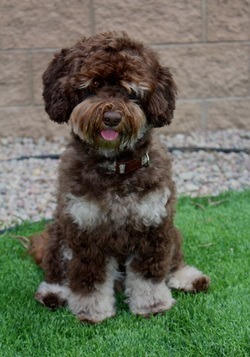


Exercise For Your Puppy
Lots of love and good nutrition are critical to a growing puppy, but exercise is also a necessity to raise a pooch who's healthy and happy for a lifetime.
Dogs can suffer from the same types of obesity-related illnesses as people, so establishing a physical fitness routine from the start is not only good for your pup, but can help you achieve your fitness goals, too. Plus, a good exercise plan for your puppy enhances good physical development and can help avoid arthritis and other joint-related problems later in life.
Physical activity is also key to a dog's psychological well-being, just like it is for people. Regular exercise promotes a substantially improved quality of life for your pup, both physically and mentally. It also can help decrease - or even eliminate - so-called "boredom behaviors" like chewing, digging, and endless barking.
What are good activities for puppies? Puppy workouts don't have to be time consuming or physically exhausting. It's all about moving and having fun. Here are some great activities you and your puppy can participate in together.
Walking
All dogs need walking. It's just that simple. Walking doesn't stress the joints, can be done in almost any weather, and provides time for you to spend together that will strengthen your bond with your pup. This is an activity that you and your puppy can enjoy together starting when your dog is about six weeks old, or as soon as he's leash trained.
Jogging/Running
Many dogs, especially the "running" breeds such as Siberian huskies, malamutes, and other dogs bred for endurance enjoy jogging or running with their owners. However, because joints and bones aren't fully formed for the first year of their lives, puppies should never be taken out jogging or running. After your pup is over a year old, though, it can be a great activity for you both.
Swimming
If your puppy likes water - as many of the retrieving breeds like Labradors and setters do - swimming can be an excellent exercise for a lifetime. Remember, though, that not all dogs like the water, and never force your puppy to get in the water if he doesn't want to. Also, be sure to provide a step or ramp system for your pup, in case it gets into your pool or spa when you're not around. Of course, the best bet is to treat dogs like kids and not let them near your pool or spa when you're not around to supervise.
Playtime
Puppies love to play, and playing is not only one of the best ways to develop a strong relationship with your dog, but also to sneak physical activity in without either of you noticing! Fetch is almost always a favorite game, and your puppy will probably enjoy playing with you using toys like soft balls, squeaky toys, and fleece toys. Choose softer toys for puppies, since their teeth and mouths aren't as strong as an adult dog's. Sticks and bones aren't good choices for play toys, as they can damage the tender mouths of dogs at any age.
Exercises to Avoid with Your Puppy
Because of his stamina level and still-forming body, running is not a good option for puppies. Extended periods of physical activity are also ill advised, since puppies' endurance levels must be built up slowly, just like a human's. Biking, rollerblading and skateboarding with your dog are unsafe, regardless of age. The chance for injury is high when you involve your dog in those types of activities - either from traffic or from the leash - and most dogs simply won't be able to comfortably keep up with you.
Exercise Guidelines for Puppies
As your puppy grows, more intensive or longer workouts are fine. Here are some guidelines by age on appropriate physical activity for your pup:
6 Weeks to 4 Months
- Short walks on soft terrain
- Playing with soft toys in a contained area, such as a fenced yard
- Swimming in warmer water for short periods
4 to 8 Months
- Longer walks on soft terrain
- Playing with soft toys
- Swimming and playing with toys in the water
8 to 12 Months
- Faster and/or longer walks on soft terrain
- Playing with soft toys
- Swimming and playing with toys in the water for longer periods
12 Months and Up
- Walks on terrain that has been checked for hazards such as unseen glass, holes, ditches, wires, stakes, and metal fragments
- Jogging with you (begin with short distances on softer terrain until endurance is built up)
- Playing with appropriate toys
- Swimming and playing with toys in the water
Regardless of your puppy's age, always be aware of signs of exhaustion, overheating, or dehydration, and stop the activity immediately. Dogs overheat more quickly than people, so be particularly alert to your pup's behavior during exercise in warmer weather. Tips to Make Exercise Fun for You and Your Puppy
- Tailor the activity to your puppy's breed, fitness level, age, and interest level
- Take your pup to the vet before starting a physical activity program
- Never force your puppy to do something he doesn't want to do
- Start slowly and let your puppy's endurance (and yours) build up to avoid injury
- Never feed your puppy immediately before or after exercising
- Check paws and pads after a workout for any cuts or tenderness
- Join a local dog club (many are breed specific) to participate in activities crafted especially for your type of dog (e.g., sled dog races, agility exercises, herding competitions)
- Let your commitment to ensuring your puppy's physical fitness help you meet your own exercise goals!
First and foremost, make sure you and your puppy are both having fun during the activity and the time you get to spend together. The bond you build while you're working out together can become unbreakable when you truly enjoy each other's company.
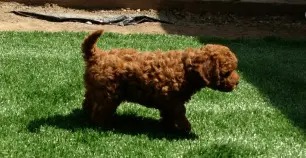
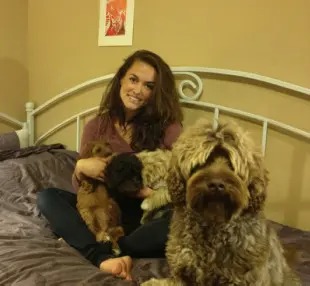
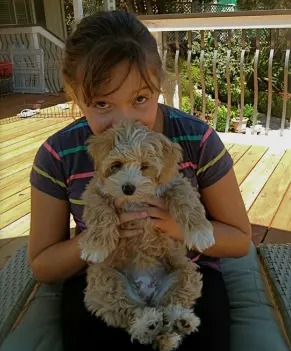


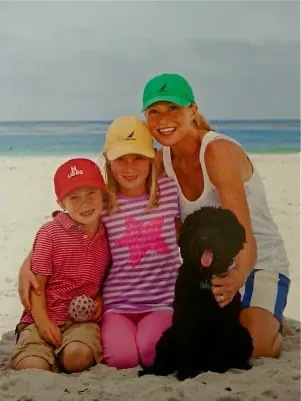
Nutrition
After years of spending a small fortune on what was supposed to be the absolute best in dry and canned dog food, I suspected food that goes through processing, extrusion, and high heat is probably food that has suffered a lot of nutrient losses. The more I read, the more I came to believe a dog’s diet is so key to their health, that it would probably be best to keep it as close to its natural “state” as possible - just like our diet. I resisted doing it for years, and for many reasons, but I finally began to feed my labradoodle's a modified raw diet - - and wow! The difference in them is nothing short of astonishing.
Modified in the fact that I still use high end/grain free kibble but subsidize it with some extra raw and cooked meats along with seasonal organic fruits and vegetables. I also use a raw dehydrated food that is reconstituted with liquid. I think it is much easier on their digestive system to add liqued back to the food. The dehydration process is done very gently so the food retains its color, its freshness, and its nutritional potency. It is also food that is easy to travel with because it requires no refrigeration (until you re-hydrate it). It is also much easier to control contamination and bacteria.
Supplementation
Regardless of how good their food is, I always add a supplement to my dog's health regimen. There are so many preservatives and pesticides in our dogs' vaccinations, flea and tick treatments, foods, treats, chews, toys, lawn, and overall environment that regardless of how good their food is and how careful and protective we try to be with them, poisonous, toxic "free radicals" are assaulting our dogs and their immune systems on a daily basis.
In fact, those free radicals have been implicated in more than fifty health problems in humans and animals including various forms of cancer, heart disease, arthritis, cataracts and premature aging.
After lots of research, trial and error the two supplements that I like the best are: Thorne Small Animal Antioxidants and NuVet Plus with Free Radical Scavengers and Antioxidants. Both are made in an FDA (human grade) pharmaceutical facility. It focuses on supporting the all-important immune system. Both can be found on-line.
Dental Care
Briefly stated, if your labradoodle's mouth isn’t healthy their body can’t be healthy. Plaque-covered teeth and inflamed gums are a recipe for damage to their vital organs. You should keep your labradoodle's teeth and gums clean and healthy! Brushing them regularly helps and so does providing them with good chew toys and chew treats. Dried green tripe treats are like flossing and brushing wrapped in a healthy treat your labradoodle will love! Avoid rawhide; instead, choose natural tendon chews, etc…Rawhide is often “cured” with formaldehyde and colored with chemicals. Bully sticks, etc. are a good choice…whose source is USA….another thing that is key! Get online, search, buy USA source products, and check the ingredients to be sure there is NO GRAIN in the treats you give your labradoodle.
Grooming
You may be wondering why this is part of health and nutrition, but trust me…it is! Your labradoodle's skin and coat speaks volumes about your dog’s overall health. The best way to stay informed about those two vital indicators is to groom your doodle on a regular basis. Groom your doodle to keep the hair free of knots - - knots become mats and from mats your dog can develop hot spots and skin issues. Groom your doodle to keep the skin stimulated and the oils distributed. Groom your doodle to re-establish bonding and “place in the pack”. Groom your doodle to be sure it is tick and flea free. The health of your doodles coat can tell you a lot about their overall health.
Male or a female? Which is best for your family?
Are you wondering whether a male or female puppy is right for you? The following information describes some of the traits common to males and females and may help you decide.
Within the dog world, females usually rule the roost. They are the ones who determine the pecking order and strive to maintain that order. They are much more intent on displaying dominance by participating in alpha behaviors such as "humping" other dogs. Most fights are generally between two females, both competing for that top position. Females tend to be more territorial, obstinate, and independent than their male counterparts. Males, on the other hand, are usually more steadfast, dependable, loyal and crave more attention from their family. Food is an easy motivator for males and helps in the area of training.Give them a treat for their positive behavior and they continue to exhibit eagerness to please. Their acceptance of other family pets and willingness to bond with children is definitely a plus.
Females will rarely demonstrate a dominance issue with their owner. They are sensitive and also eager to please, coming to you for love and attention, and then leaving as soon as they've gotten their fill. They may show cleverness or be devious in attaining their own agenda. The female also has seasons of being "in heat" unless they have been spayed. This heat cycle typically lasts for 22-28 days, roughly every six to seven or even eight months. During this time a bloody discharge can be left on carpet, furniture, concrete, or anywhere else that she may go. A walk outside during this time can become hazardous if male dogs are in the neighborhood. She will be depositing her "calling card" or scent to every unaltered male in the vicinity, regardless of breed. These males will follow you to your yard and wait for an opportune moment to associate with your female. Many unwanted pregnancies have occurred from these brief encounters.
The above mentioned traits are general gender characteristics of canines. They are not specific to the labradoodle breed. In all reality, both male and female labradoodles make GREAT family pets. We feel that the best attitude to have in choosing a new pet for your family is to have no preconceived ideas as to gender, and to just allow yourself to come and fall in love with whichever pup seems to bond best with you. However, we understand that only you can determine which gender will best suit your family, so we are here to answer any questions that you may have and greatly desire the perfect puppy for your home.